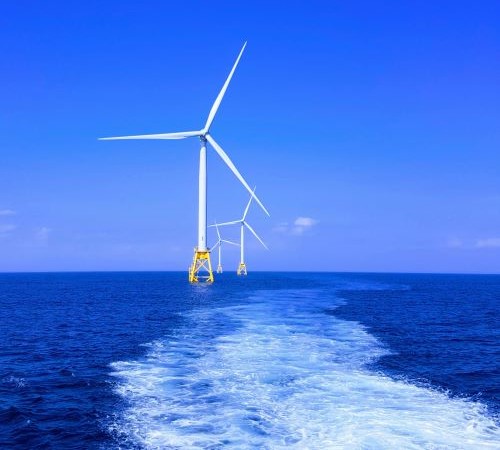Global workshop calls for urgent action from the sector
Offshore wind plays a key role in achieving net zero targets and its rapid growth in recent years has brought much-needed green energy. However, the mechanisms for dealing with offshore wind infrastructure at the end of its design life are often overlooked.
In May 2024, we hosted over 50 international sector experts for a workshop focused on safety and sustainability at the end of life of offshore wind infrastructure. At the participatory workshop, attendees considered challenges in the current system and brainstormed potential solutions. They came from industry, academia, government and other sectors, representing regions with established offshore wind infrastructure as well as emerging offshore wind markets.
In total there are 39 recommendations for stakeholders in the offshore wind sector and the report calls for a collaborative, global and inclusive systems approach.

Group picture of participants at the safer end of life for offshore wind infrastructure workshop in May 2024 (Photo by Big T Images)
We must take action now to establish the systems required – before the first big waves of commercial-scale decommissioning are due. The workshop report suggests a path forward.
Professor Susan Gourvenec FREng, Workshop and Advisory Group Chair, Professor of Offshore Geotechnical Engineering, University of Southampton
What are the end-of-life challenges for offshore wind infrastructure?
Offshore wind structures are designed and built for a certain lifetime, currently 20 to 25 years. What happens to the structures at the end of their planned design life poses complex challenges, including several concerning safety. These safety challenges range from dismantling large structures offshore and transporting them to shore, to the risks of exporting potentially hazardous waste or second-hand parts from mature offshore wind markets to other geographies, often lower- and middle-income countries. The latter regions may also be less well equipped to manage the materials safely.
These kinds of end-of-life safety challenges for offshore wind have received little attention to date. With a growing number of ageing farms, by 2035 over 3.5 gigawatts of offshore wind turbines will come to the expected end of their design life – and future decommissioning waves will be even bigger.
In other industries, such as oil and gas and shipping, the costs of a lack of proper planning and consideration of end of life have proven to be significant for human safety and the environment. Shipping is an acute example: 70% of ships are decommissioned on three beaches in South Asia and the process disproportionately affects workers and nearby communities.
As installed offshore wind capacity is accelerating and markets are emerging worldwide, what can be done differently in this sector to mitigate safety and environmental risks at the end of life?
The four key areas for action
The workshop surfaced issues and opportunities in the current system. It calls on cross-sector stakeholders to action 39 detailed recommendations in four key areas:
What are the priority recommendations?
The key findings represent substantial challenges that require all stakeholders to work together with urgency. From the workshop, priority recommendations for action on each of these findings have emerged:
- Launch a global, inclusive working group – a neutral body to establish an inclusive, international working group that can raise awareness across the sector, convene stakeholders, set benchmarking targets, and coordinate activities across regulation, supply chains, and technological developments for safe and sustainable end-of-life processes for offshore wind.
- Develop international and national standards – a neutral body to convene cross-sector actors to cocreate a framework that can be adopted by regulators. National regulators in countries with established or emerging offshore wind infrastructure will embed the framework in their respective national regulation. At the international level, the international regulatory bodies responsible will be identified and the importance of end of life raised with them.
- Collaboratively map and forecast end-of-life material flows – industry and research to jointly map end-of-life materials. First, assess when and what minimum volumes are likely to emerge, in order to inform investment, scaling, and timelines. Then, reach out to end-of-life suppliers to prepare logistically and develop the skills and workforce needed (ports, vessels, and resource management sector).
- Maximise learning by coordinating pilots and gaps – cross-sector actors to build on initiatives to map existing technologies, approaches, and pilots, and then coordinate and share learning from piloting efforts. Meanwhile, develop and train the workforce for decommissioning processes.
Conclusions

Offshore wind infrastructure is essential in a world transitioning to green energy production. As global offshore wind capacity continues to increase, planning for decommissioning must be embedded into the sector. This will ensure the safe removal and transport of these immense offshore assets as well as the responsible management of the components and materials once brought to shore.
Given the enormous scale, diminishing timelines, and categorical urgency of end-of-life projects, we must act swiftly and collaboratively to ensure the safe and sustainable management of offshore wind infrastructure at the end of its design life. Insights from the workshop show what the sector can do, where to start, and who should lead – the time for action is now.
Contact us
For further information about this project or if you have questions, get in touch by emailing Ann-Sophie Freund, Programme Manager, Safer End of Engineered Life: [email protected].
Acknowledgements
This report was produced by Engineering X based on the contributions at the workshop and with steer from an Advisory Group. We would like to thank all those who contributed to the workshop and the development of this report.
Advisory group
- Professor Susan Gourvenec FREng, Professor of Offshore Geotechnical Engineering, University of Southampton
- Lorna Bennet, Senior Engineer – Sustainability, ORE Catapult
- Professor Omar bin Yaakob, Professor in Marine Technology, School of Mechanical Engineering, Universiti Teknologi Malaysia
- Dr Anne Velenturf, Senior Research Fellow in Circular Economy, University of Leeds
- Alan William Stokes, Decommissioning Manager, Worley
Workshop participants
- We would like to thank all participants of the workshop for their time and thoughtful contributions during the workshop which form the basis of this report and its recommendations.
Related content
Critical materials - reducing demand and ensuring sustainability
A new report from the National Engineering Policy Centre about resource efficiency and demand reduction for critical ma…
Open Burning of Waste
Working together to create the conditions to enable changes in behaviour, policy, and practice to end open waste burnin…
Safer End of Life of Offshore Infrastructure and Ships
Tackling the complex social, environmental and engineering challenges of decommissioning ships and offshore structures.
